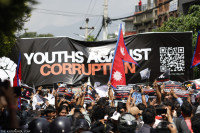Opinion
Musical Mundhum
Jhuma Limbu’s album ‘Khaasaam’ can restore faith in something nearly lost but still alive
Jhuma Limbu, a female musician, has recently released a unique musical package ‘Khaasaam’ which contains solo and ensemble performances and a booklet featuring Limbu songs. The musicals encapsulate the essential component of the Limbu Mundhum, a story of genesis and other chants. This is the result of this young singer and musician’s personal research on the singing tradition of the Limbu Vedic chants and on the repartee between boys and girls which form an important part of the Limbu musical culture. This brilliant and gifted singer, also trained in classical and Western musical traditions, has taken up personal cudgels for this. She visited Limbu performance spaces in Limbuwan regions of Nepal and Sikkim in India, participated in dhaan dances, interacted with her own people, sang and verified the authenticity of the songs and analysed them before producing this excellent piece of work. This musical package has been released at a time the Constituent Assembly is discussing the shape of the state and questions of identity and frontality in state legislative structures. In this context, I consider Jhuma’s experiment very important for the following reasons.
Walking archives
This album poses a challenge to the practice of enthnomusicological exercise in this country, especially popularised and practised by researchers who come from outside Nepal. A great portion of such enthnomusicological research is decided in advance, before coming to Nepal. Recordings play an important part in this process. Ethnomusicologists have often regarded recording as a subject of patronage or of serious failures. Many such field recordings made by ethnomusicologists in the past have not been produced in marketable cassettes or CDs with texts. Nepali ethnomusicology is thus known through these unknown recordings of researchers, who claim they are walking archives and that no one other than them hold the treasure. They have, no doubt, done a good thing by preserving the recordings. So I was both happy and shattered at the same time when Shyam Nepali, a great sarangi player gave me an assorted collection of his late father, a very talented singer, Ram Nepali’s songs that he had acquired through some Western ethnomusicologists. But none of those songs are produced in CDs or cassettes and introduced into the musical market, as far as my knowledge goes. Such is the contradiction in ethnic music and recording.
Lost sounds
Jhuma fears, very soon, no ethno musical tradition will survive with the power of resistance alone if this trend continues. So she embarked on this process of collecting or using the dormant archive of what a French art scholar and leftist politician Andre Malraux calls ‘the museum without walls’. Limbuwan is such a museum without walls for her. I too have memories of the musical tradition there because I was born and brought up in this area with these musical sounds. But Jhuma has taken up the challenge of putting together this tradition and produced an album in which she has traced the history of singing and its evolution as a researcher and principal vocalist. She was helped in this process of collection by Yaseli Yonghang, who also features in the chorus.
Creating an enthnomusicological collection without using any national archives is perhaps a very important act of resistance in itself. As an indigenous singer tracing the history of ethnomusicology through intensive, empathetic research into the vast musical and poetic repertoire—represented by the Limbu Vedic forms called Mundhums and singing formats like haakpare, paalam and other texts for choral singing—Jhuma has brought myth, spirituality and folkloristic strength together in this confluence of solo and ensemble performances. I am impressed by how she interprets the evolution of Mundhum in creation and spiritual myths and in love songs in Limbu. I have read all the Mundhums, especially those by poet Bairagi Kaanhila and Majul Yakthumba. Jhuma has done extensive survey of Mundhum and worked on a selected repertoire.
Act of courage
To trace that tradition as the heritage of singing in the Limbu culture is a very hard task that requires a great deal of patience, love, sense of resistance and, above all, a power to deliver that. Jhuma has all those qualities. After sifting the chanting, and the Mundhum verses sung by Yabas, Jhuma has come up with the following conclusion. She says, Limbu singing, the Mundhum chants in the beginning was a little rough, but with the passage of time, in her words, the chantings became melodious and even melancholic in some cases. In the album, she has taken up the singing after the Mundhum chants of creation and spirits, and of mering thakma, which is elegiac in nature. By singing Hapkare and paalam solos and putting the evolution in order, Jhuma has given credence to her reading that despite the roughness in the evolution, Limbus’ creation and spiritual chants brim with extreme human passion, melodious imagination and sense of extreme joy and bereavement.
In today’s world when we are seeking idioms to express our sense of environmental anxiety, this young woman has lent her native talent to a wonderfully meaningful endeavour. These chants and melodies and the quality of the lead singer’s voice in this package entitled Khaasaam or civilisation articulated in Mundhum chants, come as a matter of great pride to anyone who wants to promote and search such renditions of good quality music. Jhuma rightly says that her small endeavour should be seen broadly as a Nepali musician’s works. The other message is also important. Her work should inspire musicians, Nepali ethnomusicologists to look into the question of transmission of traditional music across generations, and decode the idioms and discover their flexibility. Such proactive collection and rendering as we see in Jhuma work should inspire the state, organisations, and those who produce agitprop, to listen, see and understand the power of the enthnomusicological heritage. Music can generate hope, and such indigenous musical rendering such as that done by Jhuma can create a sense of utopia, a meaningful desire to restore faith in something nearly lost but still alive.




 7.12°C Kathmandu
7.12°C Kathmandu









